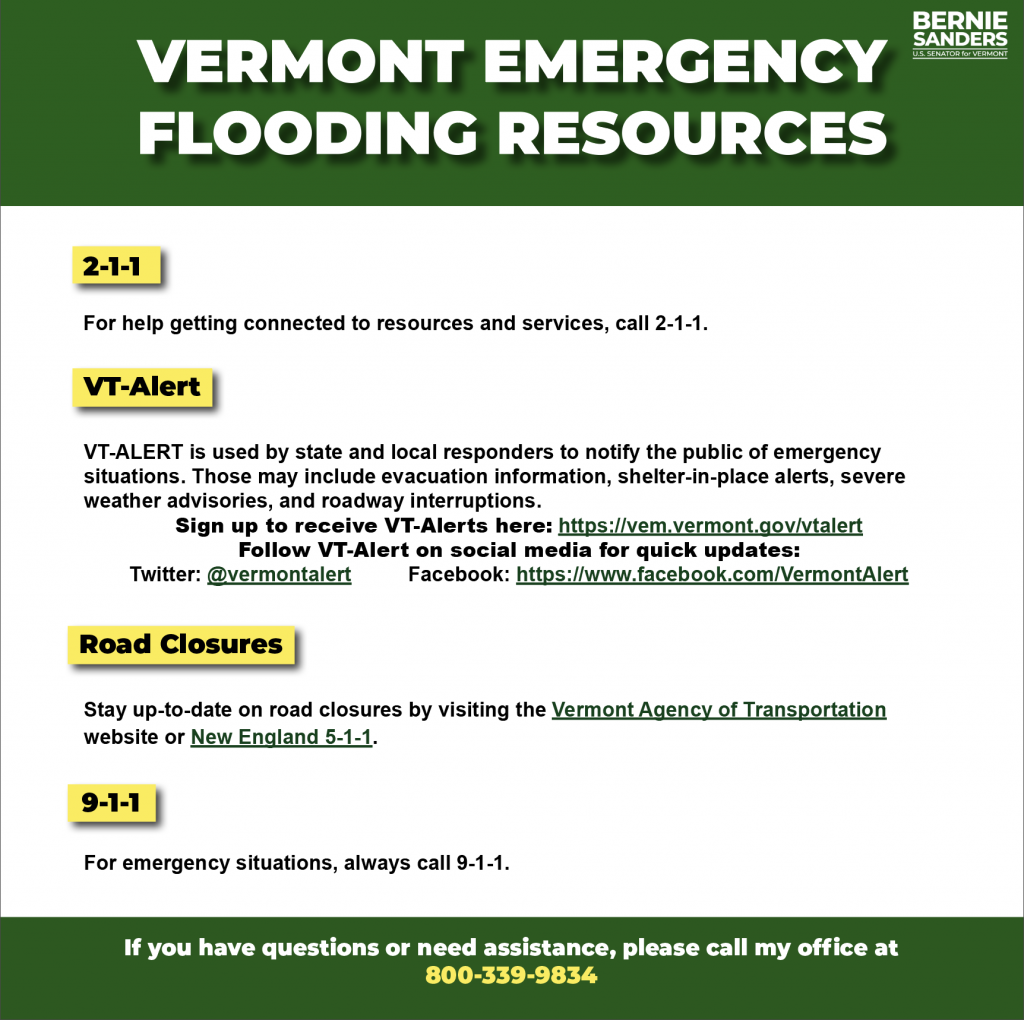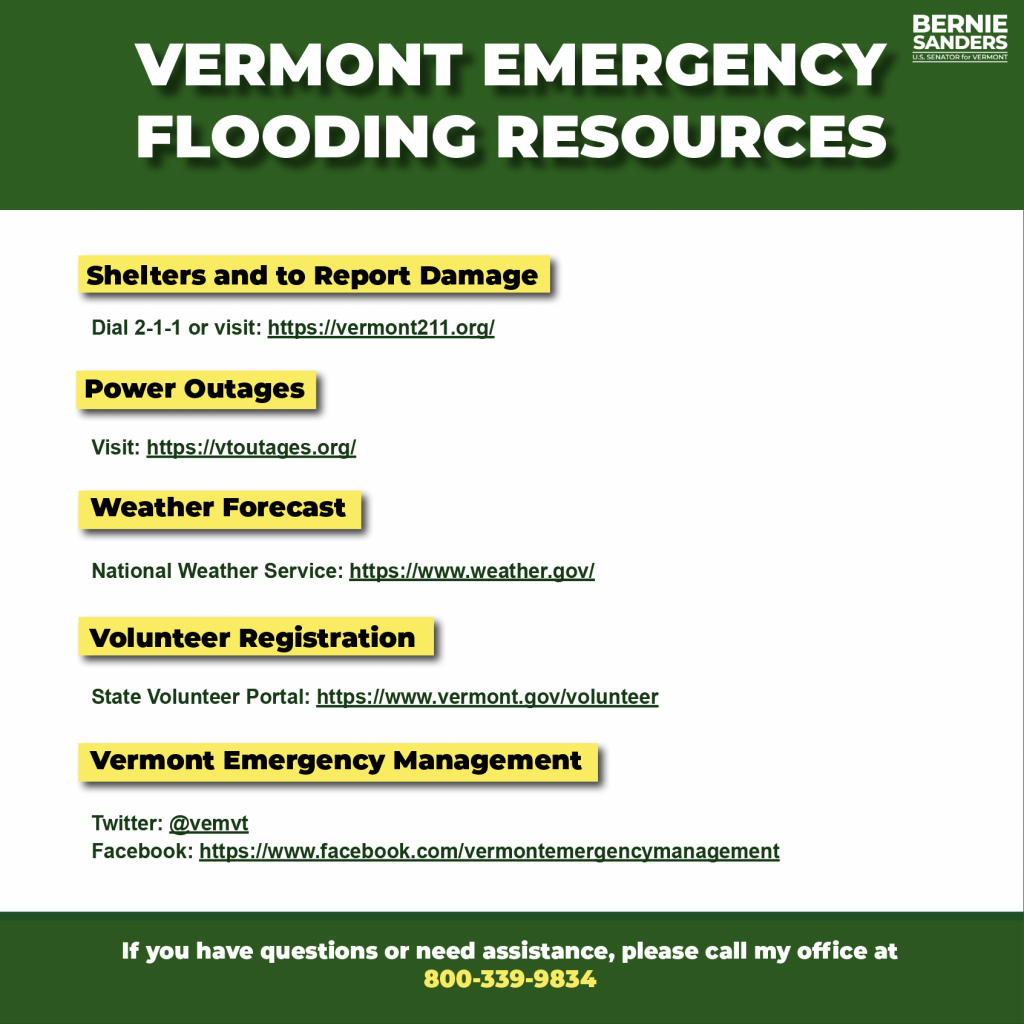The Bernie Buzz
- September 18: FLOOD RECOVERY UPDATE: Important Deadlines for Federal Assistance
- July 20: Vermonters: Please join Sen. Welch, Rep Balint, and me for a Telephone Town Meeting on the Flooding Emergency
- July 18: FLOOD UPDATE: Federal Aid for Local Businesses and Farms
- July 14: Weekend Flood Update: FEMA and Friday’s Disaster Declaration
- July 11: FLOOD UPDATE: Federal Emergency Declaration + More
- July 10: PLEASE READ: Emergency Flooding Resources
Important Deadlines
- ASAP — If you have insurance, remember to contact your home/renter/flood/car insurance carrier and file a claim as soon as possible. Remember, you can still apply for FEMA assistance and provide them with insurance information when you receive it. You have 60 days from the date on the decision letter to appeal the FEMA decision.
- September 29, 2023 — To apply for Disaster Unemployment Assistance.
- October 12, 2023 — To apply for FEMA Individual Assistance.
- October 12, 2023 — To apply for a Small Business Administration (SBA) Home and Personal Property Loan or a Business Physical Disaster Loan. Both of these loans cover physical damage.
- April 15, 2024 — To apply for SBA Economic Injury Disaster Loans. These loans help small businesses and certain nonprofits meet their working capital needs following a disaster.
- Multiple Deadlines — If you are a farmer or own an agricultural business that experienced damage, speak with your local USDA Service Center as soon as possible about your eligibility for assistance and relevant deadlines.
Sanders Issues Statement on Extreme Flooding
BURLINGTON, Vt., July 10 – Sen. Bernie Sanders (I-Vt.) today issued the following statement on the extreme flooding hitting Vermont. “In the midst of the terrible flooding we are seeing, I want to thank all the emergency crews who have been working tirelessly to protect the lives and property of Vermonters during this very difficult time…


Reporting and Documenting Your Damage
- Vermonters who suffered losses in the storm should continue to take extensive photos of damage before and during clean up and repairs, while also documenting expenses. In other words, keep your receipts.
- Please report damage to Vermont 211, either by dialing 2-1-1 or by visiting vermont211.org. This will help the state and FEMA better understand the extent of the damage.
FEMA’s Individual Assistance
President Biden approved Governor Scott’s request for a Major Disaster Declaration, which will make financial assistance available to eligible homeowners and individuals in Chittenden, Lamoille, Orange, Orleans, Rutland, Washington, Windham, and Windsor Counties. FEMA is still assessing damage in other Vermont counties. The assistance that will be available will depend upon each person’s unique situation. The types of assistance that may be available to people in these counties includes:
- The Individuals and Households Program, which can provide financial assistance for underinsured or uninsured losses, as well as assistance with home repairs and cover rental expenses if you have to leave your home.
- The Other Needs Assistance Program, which can cover the cost of replacing your essential furnishings and personal belongings.
This federal assistance is not a substitute for private insurance and likely will not compensate for all losses.
To get started and to see what assistance you may qualify for, call FEMA at 1-800-621-FEMA (3362), visit DisasterAssistance.gov, or download the FEMA App. Those who use a relay service should update FEMA with their specific number assigned to that service. Importantly, Vermonters have up to 60 days from today, July 14, to register with FEMA for Individual Assistance.
Stay Informed, Get Emergency Alerts
- 2-1-1: For help getting connected to resources and services such as shelter, disaster response, and more, call 2-1-1.
- 9-1-1: For emergency situations, always call 9-1-1.
- Vermont Emergency Management:
- Twitter: https://twitter.com/vemvt
- Facebook: https://facebook.com/vermontemergencymanagement
- VT-Alert: VT-ALERT is used by the state and local responders to notify the public of emergency situations. Those include, but are not limited to, evacuation information, chemical spills, shelter-in-place alerts, severe weather advisories, boil water advisories, and roadway interruptions. NOTE: Residents can tailor the alerts to specific locations, types of alerts, and on which devices they will be notified.
- Sign up to receive VT-Alerts, here: https://vem.vermont.gov/vtalert
- Follow VT-Alert on social media for quick updates:
- Twitter: https://twitter.com/vermontalert
- Facebook: https://www.facebook.com/VermontAlert
Homeowner’s Insurance
Homeowner’s insurance covers damage to your home, property, personal belongings, and other assets in your home. Unfortunately, most standard homeowner’s insurance policies do not cover floods. Some homeowner’s policies cover damage done by rain falling from the sky (i.e., damage caused by rain falling into a home after a roof blows off) but will not cover flood water coming into the home via the ground.
In order to avoid a denial, Vermonters should notify an insurer promptly of any loss and understand the requirements/time limits for filing a claim, document all damage, pay premiums on time, and take all reasonable steps to protect the property and mitigate the damage after the disaster. Homeowners should check their specific policy and contact their insurance company for full details. If you have concerns with your insurance company’s determination, please contact the Vermont Department of Financial Regulation.
According to Vermont insurance officials, most insurance claims for this disaster will be filed under flood insurance and car insurance, not homeowner’s insurance. Like homeowner’s insurance, Vermonters with car insurance or flood insurance should contact their insurance company as soon as possible to discuss coverage details and report damage.
Aid for Local Businesses
Under the Major Disaster Declaration, federal aid may be available to Vermont businesses that were impacted by the flooding. The U.S. Small Business Administration (SBA) will be administering low-interest disaster loans to eligible Vermonters in need. Eligible local businesses of all sizes – as well as homeowners, renters, and certain private non-profits – can apply for this aid. Additional federal resources may become available depending on further damage assessments. For more information on eligibility and to get started with your SBA application, see here and below.
Please Note: Similar to FEMA, SBA cannot duplicate benefits for losses covered by insurance. However, Vermonters should not wait to settle with their insurance company before applying for a disaster loan. If someone who experienced flood damage does not know how much of their loss will be covered by insurance or other sources, SBA can make a low-interest disaster loan for the total loss up to its loan limits, provided the borrower agrees to use insurance proceeds to reduce or repay the loan. In other words, insurance payments can be used to help pay down SBA disaster loans.
Step 1:
- Report damages to 2-1-1: Don’t forget to document the flood damage to your business and report it to 2-1-1. This will help Vermont secure more aid for impacted businesses, households, and communities across the state. You can submit the details of your damages here: https://vermont211.org/business-form#Business%20Form
Step 2
- Eligibility: Currently, the counties of Caledonia,
Caledonia, Chittenden, Lamoille, Orange, Rutland, Washington, Windham, and Windsor are eligible for BOTH Physical Disaster Damage Loans (which cover businesses, homeowners, and renters) as well as Economic Injury Disaster Loans.
Addison, Bennington, Essex, Franklin, Grand Isle, Orleans, as of now, are ONLY eligible for Economic Injury Disaster Loans. Eligible local businesses and non-profits of all sizes – as well as homeowners and renters – can apply for this aid.
- Important Deadlines: The filing deadline for businesses and individuals for Physical Disaster Damage Loans is September 12, 2023. The deadline for Economic Injury Disaster Loans is April 15, 2024.
- Want to discuss your options?:
- Recovery Centers: Vermonters should connect with the U.S. Small Business Administration to discuss loan options and eligibility. One of the best ways to do this is by visiting one of SBA’s Business Recovery Centers set up on the ground in Vermont for local businesses that were impacted by the floods. Learn more and find a recovery center near you, here: https://accd.vermont.gov/flood. You can also reach the SBA helpline at 1-800-659-2955, or the VT SBA offices at 802-828-4422. Recovery Center locations may be subject to change, so please check the website for updates.
- VT Small Business Development Center: The VT Small Business Development Center can also help business owners think through their options. You can find more information on their website at: https://www.vtsbdc.org/
- How to Apply:
- Applicants may apply online, receive additional disaster assistance information, and download applications at: https://disasterloanassistance.sba.gov/ela
- Applicants may also call the U.S. Small Business Administration’s Customer Service Center at 1-800-659-2955 or email disastercustomerservice@sba.gov for more information on SBA disaster assistance.
- If you are deaf, hard of hearing, or have a speech disability, please dial 7-1-1 to access telecommunications relay services.
- If you choose not to submit your application online, completed applications should be mailed to U.S. Small Business Administration, Processing and Disbursement Center, 14925 Kingsport Road, Fort Worth, TX 76155.
Aid for Farmers and Agricultural Businesses
Are you a farmer or someone involved in another form of agricultural business? If so, you may be eligible for disaster assistance through the United States Department of Agriculture (USDA), including through the Farm Service Agency (FSA) and the Natural Resources Conservation Service (NRCS). It is important to contact your local Service Center early to discuss your options and begin the application process ahead of upcoming deadlines. You can find your local Service Center here: https://offices.sc.egov.usda.gov/locator/app?state=vt&agency=fsa. See below for more details, as well as some additional resources:
- USDA Disaster Assistance: USDA covers damage to livestock, farmland, financial damage, and crop losses. For more information, visit https://www.fsa.usda.gov/programs-and-services/disaster-assistance-program/index or call (855) 794-3676.
- Vermont Farm Fund Emergency Loans: Qualifying applicants must be Vermont farmers or food producers who have suffered a significant loss due to an unexpected natural disaster that puts their farm or farming career in danger. This covers buildings, animals, equipment, greenhouses, and hay fields. For more information visit www.vtfarmfund.org/emergency-loan or call 802-560-3099.
- VT Agency of Agriculture Farm Related Assistance: For more information visit https://agriculture.vermont.gov/flood or email agr.floodresponse@vermont.gov or call 802-828-5667.
- Farmer Emergency Fund: For more information visit www.nofavt.org/farmer-emergency-fund or call 802-434-4122.
- Support for Farmers: Connect with technical, legal or financial assistance, or to a counselor or trained peer. See here for more information: https://www.farmfirst.org/
Some Flood Safety Best Practices
- Never drive or walk through floodwaters. Strong currents or unseen washouts can sweep you and your car away.
- Turn off the circuit breaker in your home before you evacuate – if you can do so safely.
- If rising water is approaching, leave.
- If you need to evacuate, do so over high ground. Plan that route as soon as possible.
- If your home floods, have a licensed electrician inspect your electrical system before you once again occupy your home.
- If you are in a flood-prone area, or if you believe your home will be flooded, it is advisable to move valuables from your basement in case water enters your home.
- Check your insurance coverage now, and then contact your insurance company if you have damage.
Roads and Alerts
- For a list of state road closures visit: https://newengland511.org/
- Track river forecasts and levels here: https://water.weather.gov/ahps2/index.php?wfo=btv
- Register for Vermont Alerts at www.vtalert.gov to receive up-to-the-minute safety warnings.
Shelters and Drying Centers
If you are in need of shelter or a drying center, please see the Vermont 211 website or dial 2-1-1 for the latest.
Mental Health
Many Vermonters are going through a traumatic period. If you or someone you know is having a hard time with the emotional impact of this crisis, you can call or text the National Disaster Stress Hotline, 1-800-985-5990, or 9-8-8.
Volunteers
This recovery will be long. To get through this together, we will need many helping hands in the coming weeks, months, and even years. To help those affected by the flooding, you can register for the “State of Vermont Volunteer” organization here: Vermont.gov/volunteer. Do not self-deploy to affected areas as you could put yourself at risk.
